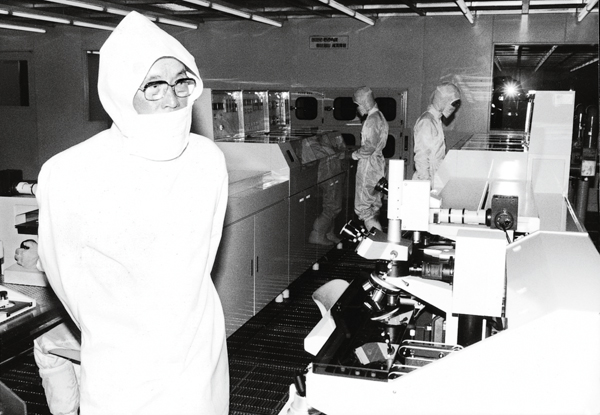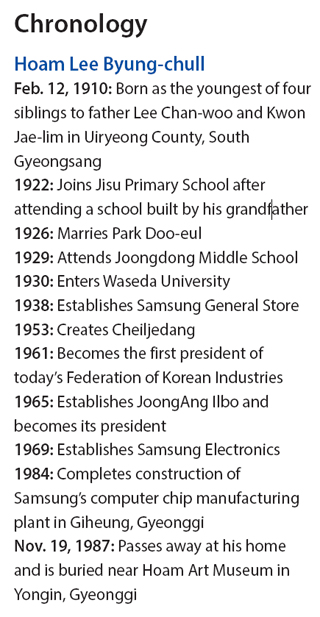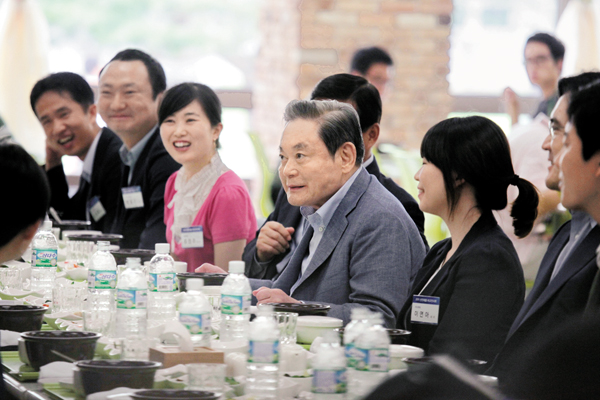[Dynasty Korea’s corporate roots] Samsung founder Hoam risked it all to succeed
Published: 27 Mar. 2016, 19:52

Samsung Group founder Hoam Lee Byung-chull monitors the company’s semiconductor production line in 1985. [SAMSUNG]
His son, Lee Kun-hee, is recognized for making Samsung Group not only the No. 1 conglomerate in Korea, but also a global competitor capable of going toe-to-toe with companies around the world.
The elder Lee’s pen name, Hoam, means “to calmly fill with clear water, as in a lake,” as well as “the sternness of an unshakeable rock.”
Hoam was born on Feb. 12, 1910, in Uiryeong County, South Gyeongsang, as the youngest son of four siblings to father Lee Chan-woo and mother Kwon Jae-lim. His grandfather, Lee Hong-seok, was a scholar who built the school Hoam attended from ages 4 to 6. At an early age, Hoam didn’t seem particularly brilliant. It took him a year to learn Chinese characters, while others finished in just two to three months.
The other children laughed at him, and even the teacher told him to work harder.
In response, Hoam buckled down on his studies. Within five years, he had memorized major books like “The Analects” of Confucius and the Seven Chinese Classics. The former had a huge influence on the future business mogul. It became his guidebook through life and informed how he believed he ought to behave.
Hoam hated to lose, and when he fought, no matter how bigger or older his opponent, he would eventually force the other boy to submit.
His grandfather was very financially savvy and was able to profit off his business endeavors.
Hoam’s father, Lee Chan-woo, would eventually finance the independence movement during the Japanese colonial period, and during his teenage years, he also became friends with Korea’s first president, Syngman Rhee.
Because of his father’s close friendship with Rhee, Hoam was able to frequently meet with him after Korea gained its independence.
They first met on one of Rhee’s early visits to Daegu. Hoam introduced himself as the son of Lee Chan-woo, and Rhee greeted him enthusiastically. Rhee invited Hoam to pay him a visit the next time he was in Seoul, and Hoam followed through the following year. Though the meeting wasn’t prearranged, Syngman Rhee made time for Hoam.
Hoam visited Rhee again in 1960 to tell him he planned to build a $50 million fertilizer plant financed with loans from Europe rather than with handouts from the Korean government.
Rhee liked the idea and presented the young businessman with a statement pledging the government’s support.
In 1922, Hoam briefly attended Jisu Primary School in Jinju, South Gyeongsang, before transferring to what is now Seoul Soosong Elementary School. Hoam’s modern education began when his older sister, Lee Boon-si, took him to the barber and cut off his long lock of hair, which was tradition at the time.
In 1925, he moved up to Seoul Joongdong Middle School. While in school, he received a letter from his father telling him he needed to return home to be married.
At the age of 18, he was wed to Park Doo-eul, the fourth-youngest daughter of Park Ki-dong, who lived in Dalseong County, North Gyeongsang. She was a descendent of Park Paeng-nyeon, one of the six martyred ministers.
Hoam’s eldest son Lee Myeang-hee in his own biography said he was told by the elders that when his father married his mother, his mother’s family was much richer. She even brought several servants with her.

In April 1930, he entered Waseda University to study political science and economics. He listened to lectures closely and read various books on the economy, including Karl Marx’s critique of capitalism. He sat in the front row and showed up much earlier than everyone else. Given the chance, he would visit famous industrial sites in Japan, which informed his own factories later in life.
But it all came crashing down in less than a year, when Hoam fell ill with beriberi and was forced to return home.
Hoam went to his father and told him that he planned to start a business. He traveled to Masan with two friends and opened a rice mill in March 1936. But there was a sudden, massive economic downturn, and he recorded huge losses. He licked his wounds, studied all the reasons for his failure and made changes that quickly had him recording windfall profits.
As his rice mill business became successful, he then bought Japan’s Hideno Automobile in August that same year and started a transportation business with 20 trucks. And from the profit he made, he became the landowner of 6.6 million square meters (1,600 acres) in 1937. The following year, he opened up the Samsung General Store in Daegu and took over Chosun Alcohol. When Korea gained its independence in October 1945, he was already participating in the management of a news outlet, Daegu Minbo.
In November 1948, he established the Samsung Trading Company - today’s Samsung C&T - in Jongno, Seoul. The company began trading with several markets including Hong Kong, Macau and Singapore. Hoam, who was the trading company CEO, invested 75 percent while then-senior executive Cho Hong-je, who later became the founder of Hyosung Group, and executive Kim Saing-ki, who later founded Yungjin Pharmaceutical, and others put up the remaining capital.
In less than a year, the company had become the No. 1 trading company in the country.
When the Korean War broke out on June 25, 1950, he wasn’t able to return home because he had fallen ill. He returned to Daegu in December. The following year, he reopened the Samsung Trading Corporation in Busan, which was the temporary capital of South Korea. In 1953, he founded Cheiljedang, and in 1954, he founded Cheil Industries. During the war, he realized the most urgent issue was the manufacturing of daily necessities and decided to create an industry that could do away with the need to import the goods.
His business really began to expand in 1957, when he began to acquire several financial companies including Chohung Bank and Ankuk Fire and Marine Insurance, today’s Samsung Fire and Marine Insurance. He also bought shares of many Korean companies and became the majority shareholder in companies like Honam Fertilizer and Hankook Tire. It was around this time he became known as the owner of Korea’s first conglomerate.
When the military coup occurred on May 16, 1961, Hoam was on a business trip in Japan. He immediately returned home to meet with then-leader Park Chung Hee, where he proposed a nationwide economic development plan made possible by cooperation from the business community. The move earned the release of 11 businessmen that had been arrested on charges of unlawfully accumulating wealth. It also made him the first chairman of today’s biggest business lobby, the Federation of Korean Industries.
He next took an interest in media, and established the broadcasting network TBC - today’s JTBC - in 1964. The following year, he created the JoongAng Ilbo.
TBC quickly became the nation’s highest-rated broadcasting station, but it was closed during the new military regime of Chun Doo Hwan in 1980. The JoongAng Ilbo spun off from Samsung in 1999.
Hoam was known to say that he managed Samsung with the intention of contributing to the greater good of the nation.

Chairman Lee Kun-hee meets with Samsung executives to discuss creating products competitive with those from companies in other advanced economies in 2011. [SAMSUNG]
He realized his vision turned out to be more difficult than he expected. When he met with computer experts and businessmen in Tokyo in 1983, he was told that he would regret not offloading his semiconductor business then and there. At the time, the price of semiconductor chips didn’t even come close to production costs, and even then, they were hard to sell. But despite opposition from even his own executives, Hoam decided to forge ahead. In every business, there is risk, he would say, and Samsung only has a future when it takes on and overcomes these kinds of dangers.
His decision would become the foundation for Samsung’s continued success and growth into a multinational company.
Hoam passed away on Nov. 19, 1987, at his home and was buried near Hoam Art Museum in Yongin, Gyeonggi.
In the room where he took his last breath, there is a framed quote: “I come with empty hands, and I go with empty hands.
The fact that Samsung Group’s memory chip business today is No. 1 in the world is the result of a joint effort by Hoam and his son, current Samsung Chairman Lee Kun-hee.
If Hoam built the foundation of the business, Lee Kun-hee made it blossom.
According to Kang Jin-ku, the former chairman of Samsung Electronics, in 1974 then-Vice Chairman Lee Kun-hee proposed to his father they enter the semiconductor business by acquiring the bankrupt Korea Semiconductor.
But when Hoam was wary because of the company’s small size, Lee Kun-hee convinced him of the business’s importance and necessity. He even spent some of his own money to acquire the company.
Lee Kun-hee strongly believed that an electronics company without a semiconductor business is same as an automobile company without any engine technologies.
It has been said that when Lee Kun-hee was in kindergarten, he would wear only black rubber shoes. This was because he valued pristine white shoes over everything else and would hide them to keep the treasure as long as possible.
Lee Kun-hee enrolled at Hyehwa Elementary School in Jongno, Seoul, in 1949. But when war broke out, he enrolled in school at Masan, South Gyeongsang, before relocating back to Daegu and then again to Busan.
Former CEO of Hankyure Kwon Keun-sool, who was a classmate of Lee Kun-hee in fourth and fifth grade at Busan National University of Education Elementary School, remembers hanging out with the future chairman of Samsung Group. He said Lee Kun-hee had many rare toys, like an airplane that would rotate when hung from a string on a ceiling or a motorized train that would run on tracks. But to little Lee Kun-hee, the expensive toys weren’t just for play. To him, they were a subject of scientific inquiry. He would disassemble and then reassemble them again and again. Such a hobby continued throughout his life, when he was in charge of the semiconductor business. He even reached the level where he would take an automobile apart and reassemble it.
In 2002, the 15-year anniversary of Lee Kun-hee’s inheriting of his father’s business, a miracle happened. Samsung Group’s annual revenue grew more than tenfold, from 13.5 trillion won ($11.6 billion) to 137 trillion won. Net profit also expanded from 190 billion won to 15.1 trillion won.
Lee Kun-hee surprised the global business community in April 2002, when Samsung outperformed Japanese tech giant Sony.
In 1993, just five years after becoming head of Samsung Group, Lee Kun-hee made an ambitious announcement. He said he would sacrifice his own fortune, and even his life, for the betterment of Samsung Group.
In 1998, when faced with the devastating blow of the IMF crisis, he overcame it all by promising to put everything he had on the line.
In 2013, Samsung Group’s annual revenue increased to 390 trillion won, exceeding even the government’s total revenue of 360 trillion won.
But on May 10, 2014, at own house in Hannam-dong, Lee Kun-hee suffered a heart attack. He is currently undergoing rehabilitation at the Samsung Medical Center in Ilwon-dong, southern Seoul. His son Lee Jae-yong reportedly visits him every single day.
Lee Jae-yong took the first steps toward inheriting the family business in May 2015 when he took over his father’s role in two Samsung charitable foundations.
The British magazine The Economist wrote, “The foundations are also seen in South Korea as the family’s public face: they support good causes, such as child-care centres for poor families, and the stunning Leeum museum in Seoul.
“Taking charge at the charities will help cement the younger Mr. Lee’s image as a softer, more reflective leader than his father. It is also seen as one of the final steps before he ascends to the corporate throne.”
He has started to expand Samsung Group by meeting with the founder of Paypal to discuss fintech or traveling to Switzerland to discuss the bio businesses with global drug company Roche. He also ended the patent war with Apple and Microsoft to focus more on the future.
BY KIM DUCK-HYUNG [lee.hojeong@joongang.co.kr]










with the Korea JoongAng Daily
To write comments, please log in to one of the accounts.
Standards Board Policy (0/250자)